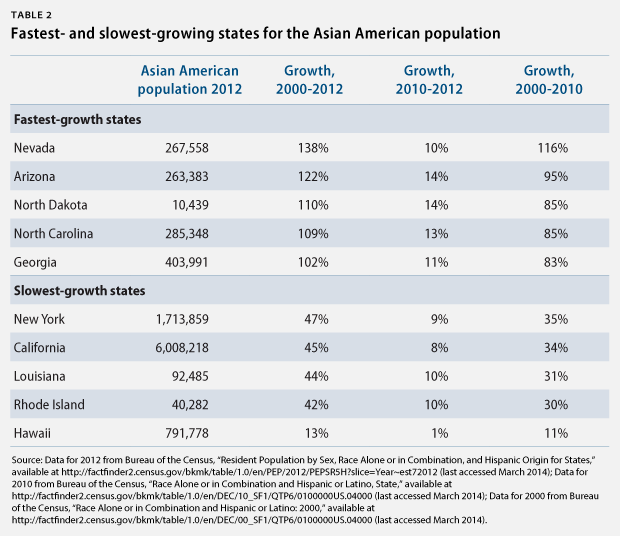Over the past decade, more immigrants have come to the United States from Asia than from any other region in the world, making Asians the fastest growing immigrant population in the United States. These immigrants bring their diverse cultures, language skills, and different economic and demographic traits from various Asian countries and the Indian subcontinent. As we celebrate Asian-Pacific American Heritage Month this May, here is a look at the demographics of Asian immigrants and the important role that Asian immigrants play in American society.
Demographics of the Asian immigrant population
Today’s Asian immigrant community in the United States is diverse: Chinese, Filipino, Indian, Vietnamese, Korean, and Japanese immigrants are the top six nationalities of Asian immigrants and account for 85 percent of the total Asian immigrant population. These immigrants have contributed greatly to the overall growth of the U.S. Asian population. Since 2008, Asian immigrants have represented approximately 40 percent of the U.S. foreign-born population compared to 27 percent in 2005. The U.S. Asian population is also majority-foreign born: 66 percent of Asian Americans were born in another country, compared with only 37 percent of Latinos.


More than half of all Asian immigrants live in five states: California, New York, Texas, New Jersey, and Hawaii. California alone is home to more than one-third of the national population of many of the largest Asian immigrant groups, including Filipinos, Chinese, and Vietnamese. Even so, Asian immigrants are moving to new destinations, such as Nevada, Arizona, North Dakota, North Carolina, and Georgia, all of which saw their Asian immigrant population more than double between 2000 and 2012.
Asian immigrants and United States immigration system
While many reasons bring Asian immigrants to the United States, the biggest migration pathway is through family-sponsored visas for relatives of U.S. citizens. For example, among Asian immigrants, 55 percent of visas in 2012 were issued through family-sponsored preferences, of which 35 percent were issued to immediate relatives of U.S. citizens.
Nonetheless, Asian immigrants face some of the longest backlogs for visas of any immigrant group. The Immigration and Nationality Act caps visas at 26,000 for any single country. Consequently, countries with the highest family- and employer-sponsored visas have to wait years before reuniting with their families. For example, siblings of adult U.S. citizens from the Philippines wait for more than 25 years for a green card, while the siblings of adult Chinese Americans wait for more than 14 years. Overall, an estimated 4.2 million individuals from Asian countries are currently stuck in family-visa backlogs.
In addition to family-sponsored visas, many Asian immigrants enter the United States through avenues such as temporary work permits and student visas. For instance, 70 percent of the 316,000 H-1B visas approved in 2014 were for Indian immigrants, making India the second-largest Asian country to send workers to the United States after China.
Finally, Asian immigrants comprise a significant portion of the undocumented population. An estimated 1.5 million of the 11.5 million undocumented immigrants living in the United States in 2013 were from Asian countries, with India accounting for the fastest growing group of undocumented Asian immigrants. Close to half a million undocumented Asian Americans are eligible for temporary relief under the Deferred Action for Childhood Arrivals, or DACA, and Deferred Action for Parents of Americans and Lawful Permanent Residents, or DAPA, programs.
Asian immigrants and the economy
Asian immigrants play an important role in helping the U.S. economy thrive. The most recent Census Bureau Survey of Business Owners found that Asian immigrants owned 1.5 million businesses, which had total sales and receipts of $506 billion and employed 208 million people in 2007. The number of Asian immigrant-owned businesses increased 40 percent from 2002 to 2007, compared to the average increase of 18 percent for all U.S. businesses.
Asian immigrants also play an important role in the consumer market. They hold the fastest-growing buying power share—also known as spendable income after taxes—of any racial or ethnic group in the country. The Selig Center at the University of Georgia’s Terry School of Business estimates that the cumulative buying power of Asian immigrants grew from $274 billion in 2000 to more than $700 billion in 2013.
Asian immigrants and their education
Asian immigrants as a whole have a higher education completion rate than the overall U.S. population. But this aggregation masks big differences across Asian origin groups. For instance, groups that arrive in the United States on employment-based visas have some of the highest levels of educational completion, while those who arrive as refugees have the lowest levels of educational attainment. Moreover, a Pew Research Center survey reported that 7 in 10 Asian Indian American adults ages 25 and older have a college degree compared to about half of Japanese, Korean, Chinese, Vietnamese, and Filipino immigrants. Additionally, Asians make up 13 percent of the limited English proficient, or LEP, population. With more Asian immigrants entering the workforce, ensuring that the entire population is English proficient is essential to the nation’s economic growth.
Conclusion
Even as Asian immigrants become a larger share of the U.S. population, they face distinct challenges. For one, political parties often overlook Asian immigrants due to language and cultural barriers that make them hard to reach. Another concern for Asian immigrants is the model minority stereotype, which asserts that the majority of Asian immigrants have already achieved the American Dream. In actuality, Asian immigrants comprise many subgroups with very different and diverse needs and are not exempt from issues, such as poverty or unemployment, that face portions of all groups living in the United States.
As this population grows, it is imperative that politicians, lawmakers, and the general public learn more about these communities and their needs. A permanent solution from Congress to reform the current immigration system will help facets of the Asian immigrant community succeed economically, reunite their families, and integrate further into American society.
Sanam Malik is the Special Assistant for the Immigration team at the Center for American Progress.